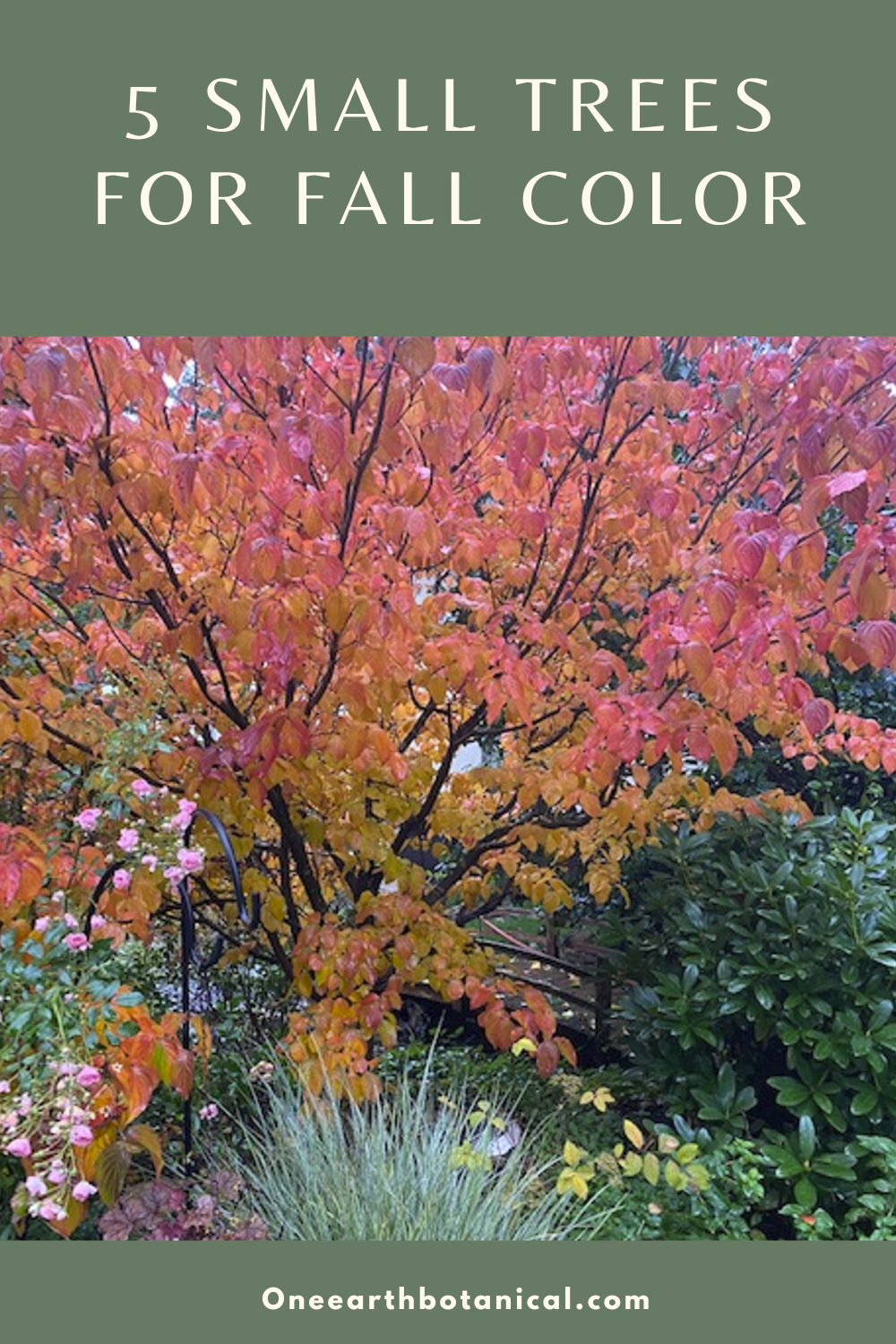One of the greatest joys of gardening is standing witness to the everchanging Kaleidoscope of color through the seasons and Autumn is the crescendo. It’s a time when the veil between worlds is thin and the plant kingdom shows its true colors. Much of the year chlorophyll colors leaves, but in the Autumn chlorophyll disappears and true colors emerge.
I’d like to share with you some small trees strutting their stuff this year. All of these selections are compact and would be good choices to add a pop of rich fall color to small landscapes.
Sourwood Tree Oxydendrum arboreum
As I write this the Sourwoods are the most brilliant thing in the landscape. They begin blushing peach colors late summer and the colors intensify over many months. Panicles of white flowers begin late summer and continue through fall, adding to the beauty and providing my bees with a rich late season nectar source. Sourwood honey is highly sought after. I always have something flowering, but these trees are a favorite when looking for a small tree with big impact. They should be more widely planted for the bees and for the sheer beauty in our landscapes. Growing up in Pennsylvania they were always one of my favorite native woodland trees. Sourwood trees are often multitrunked and are fairly compact compared to most trees, making them perfect for smaller spaces. They need at least a half day sun to exhibit their beautiful fall colors. Full sun brings out the best color and flowering. Sourwood trees have a bit of a multitrunked wild look about them and aren’t particularly refined enough to be placed alone as a specimen. In nature, they can often be seen at the edge of a forest and look especially nice situated between larger trees or tucked under our towering conifers on the sunny side. They have fine roots and don’t appreciate root competition or being disturbed by foot traffic. They benefit from deep mulch around the base to retain moisture and protect the roots. Ht 25’ X W 15’.
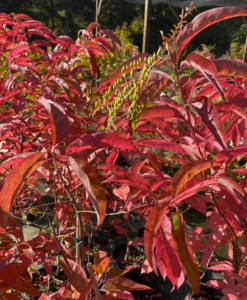
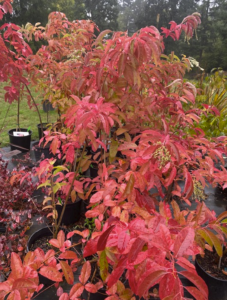
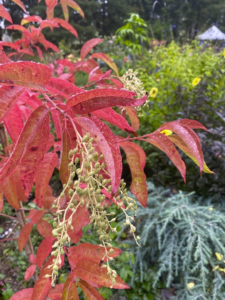
Photos by ‘One Earth Botanical’
Stewartia pseudocamellia AKA Japanese Stewartia Tree
One of the most elegant and beautiful small specimen trees. Cute buds dot the tiered branches and open in summer to crisp white saucer shaped flowers with a yellow central boss. As the tree ages it takes on more character with a twisted form and the bark begins to peel revealing a patchwork of pink, brown and grey colors. Stewartia trees are fairly slow growing and retain a very narrow form, perfect by a house or walkway. They make a perfect specimen situated against a green backdrop to feature the multi-colored bark, lovely flowers and to make all the outstanding features pop. Stewartia trees erupt in fall with brilliant scarlet, red and orange foliage. Stunning. Full sun to light shade. Fall colors are muted in too much shade. Only 12’ tall in 10 years. Mature Ht. 25’ x W 12’ Zone 5-8
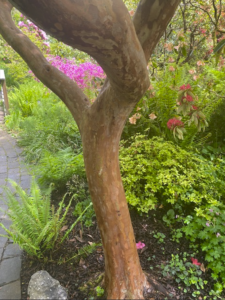
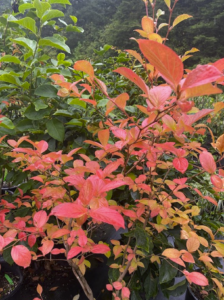
Photos by ‘One Earth Botanical’
Enkianthus companulatus ‘Showy Lanterns’
An underused gem for sun or part shade with pinkish-red bell-shaped flowers in spring that attract hummingbirds and display rich scarlet fall color. Such an easy to grow shrub to small tree that thrives in our PNW climate. Related to rhododendrons, it appreciates acidic soil and can grow in shade or full sun. More sun brings the scarlet color, but if planted in more shade you can expect a bright yellow display with orange overtones. Young specimens can look a bit rangy, but allow a bit of time and try to refrain from pruning, knowing that it takes on a more elegant branching structure with age. So worth the wait. Mature size 10’ tall and 5 ft wide. Enkianthus ‘Showy Lanterns’ loses it’s leaves in winter, but with a dense branching structure it maintains an interesting winter silhouette.
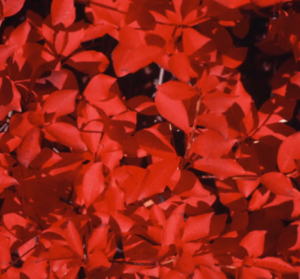

Photos compliments of ‘Briggs Propagators’
Cornus kousa Dogwood
Cornus kousa dogwoods display a range of brilliant fall colors in shades of red, orange, scarlet, purple and deep burgundy. There are many cultivars to choose from. The Cornus kousa varieties have an elegant vase shape with a layered branching pattern on a small to medium tree. Edible, strawberry like red fruits decorate the tree in late-summer and fall foliage is a brilliant riot of color. The fruit is best when fully ripe and is dotted with seeds and a bit mealy tasting. Most people leave them for the birds, but they make a nice garden nibble and a good jam when sweetened.
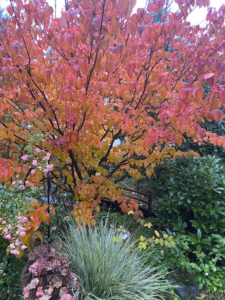
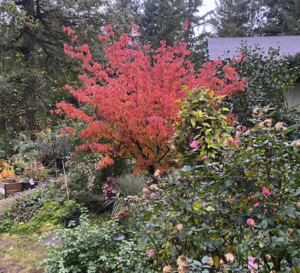
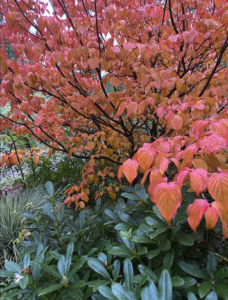
Photos by ‘One Earth Botanical’
Acer palmatum Japanese Maples
Well… Duh. We all know Japanese maples are a fabulous source of fall color and with so many to choose from that’s another article for another day. Whatever color you’d like to bring to your fall landscape there’s a maple for that.
This post may contain Affiliate links. I only share products I like or use myself. If you click on those links I may get a small commission at no extra cost to you. It helps keep this blog going. Full Disclosure Here:
What do you think is the best small tree for fall color? Let me know. I love to hear from you!
With Gratitude,
“Trees generously provide us with clean air, food, shade, habitat, wood and beauty. Planting trees is an affirmation of the future, a gift to the Earth, our children and those to come.“
Stephanie Beach
Oneearthbotanical.com

